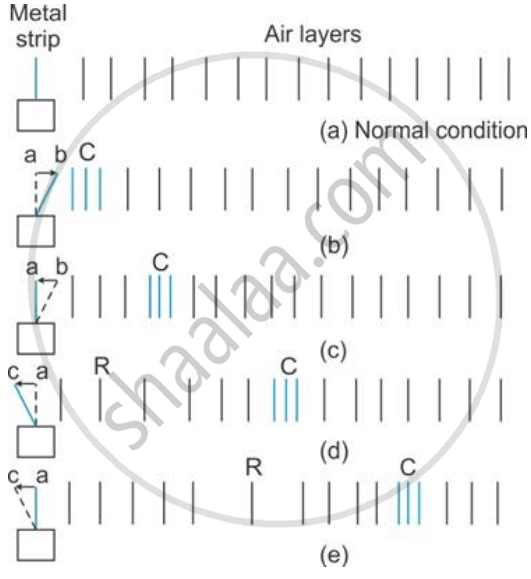Advertisements
Advertisements
Question
Explain with an example, the propagation of sound in a medium.
Solution
Take a vertical metal strip with its lower end fixed and upper end being free to vibrate as shown in fig (a).
As the strip is moved to right from a to b as shown in Fig (b), the air in that layer is compressed (compression is formed at C). The particles of this layer compress the layer next to it, which then compresses the next layer and so on. Thus, the disturbance moves forward in form of compression without the particles themselves being displaced from their mean positions.
As the metal strip returns from b to a as shown in Fig (c) after pushing the particles in front, the compression C moves forward and particles of air near the strip return to their normal positions.
When the strip moves from a to c as shown in Fig (d), it pushes back the layer of air near it towards left and thus produces a low pressure space on its right side i.e. layers of air get rarefied. This region is called rarefaction (rarefaction is formed at R).
When the strip returns from C to its mean position A in Fig (e), the rarefaction R travels forward and air near the strip return to their normal positions.
Thus, one complete to and fro motion of the strip forms one compression and one rarefaction, which together form one wave. This wave through which sound travels in air is called longitudinal wave.

APPEARS IN
RELATED QUESTIONS
Name the two kinds of waves in form of which sound travels in a medium.
What is a longitudinal wave? In which medium: solid, liquid or gas, can it be produced?
Explain the terms crest and trough in relation to a transverse wave.
How is the frequency of a wave related to its time period?
How does the speed of sound change with change in (i) amplitude and (ii) wavelength, of sound wave?
Why do astronauts talk to each other through radio telephone in space?
State the main factors on which the speed of sound in a medium depends.
Does sound require a material medium for transmission?
How will the following factors affect the speed of sound in air:
Temperature of air.
How will the following factors affect the speed of sound in air:
Wind.
